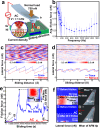Tuning friction force and reducing wear by applying alternating electric current in conductive AFM experiments
- PMID: 40394013
- PMCID: PMC12092833
- DOI: 10.1038/s41467-025-59989-4
Tuning friction force and reducing wear by applying alternating electric current in conductive AFM experiments
Abstract
Reducing friction has been a human pursuit for centuries, and is especially important for the development of nanotechnology. Nowadays, with the atomic-level understanding of friction, it is possible to reduce friction by modulating the configuration and motion of interfacial atoms. However, how to further reduce friction by modulating the interfacial electronic properties is still unclear. Here we show a strategy to achieve friction and wear reduction through inducing dynamic electronic density redistribution via alternating electric current. The friction force between conductive Ir AFM tip and graphene on Ni substrate can be reduced to 1/4 under 1 kHz alternating current, and maintain for more than 70,000 s under 9.1 GPa contact pressure without any obvious wear. An electronic-level friction model (PTT-E model) is presented to unravel and quantify the tuning effect, showing that the alternating current induced dynamic electron density redistribution is the key to friction reduction. This work proposes a feasible and robust method to reduce friction and wear in nanomechanical devices, and advances the understanding and predicting of electronic contribution in friction tuning.
© 2025. The Author(s).
Conflict of interest statement
Competing interests: The authors declare no competing interests.
Figures





References
-
- Holmberg, K. & Erdemir, A. Influence of tribology on global energy consumption, costs and emissions. Friction5, 263–284 (2017).
-
- Berman, D., Deshmukh, S. A., Sankaranarayanan, S. K., Erdemir, A. & Sumant, A. V. Macroscale superlubricity enabled by graphene nanoscroll formation. Science348, 1118–1122 (2015). - PubMed
-
- Zhang, S., Ma, T. B., Erdemir, A. & Li, Q. Y. Tribology of two-dimensional materials: From mechanisms to modulating strategies. Mater. Today26, 67–86 (2019).
-
- Carpick, R. W. Physics - Controlling friction. Science313, 184–185 (2006). - PubMed
-
- Bresme, F., Kornyshev, A. A., Perkin, S. & Urbakh, M. Electrotunable friction with ionic liquid lubricants. Nat. Mater.21, 848–858 (2022). - PubMed
LinkOut - more resources
Full Text Sources
Miscellaneous

